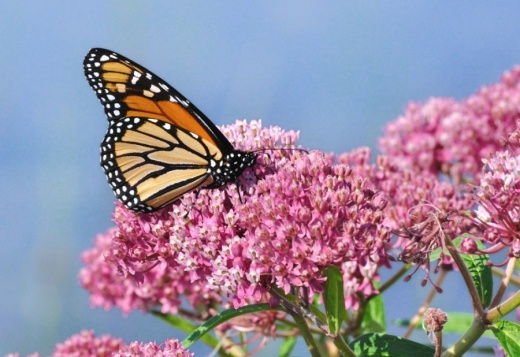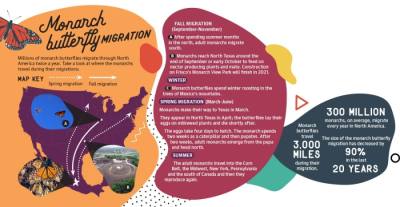Construction on the 13-acre Monarch View Park started in April along Teel Parkway. According to city staff, Frisco is in the migration path for the monarch—a widely recognizable insect known for its black and orange markings—and to assist with their trip, the park will include the restoration of native plants and landscape.
“This is a really unique opportunity for us to be able to do some restoration to make sure that those butterflies still come through,” Parks and Recreation Director Shannon Coates said.
A new kind of park
Not only is Monarch View Park larger than the typical eight-acre neighborhood park in Frisco, but it will also have unique passive components along with active portions in its walking trails, playground and sports area, Coates said.
“It won’t be full of athletic fields,” she said. “Instead, it’ll be a combination of those active pieces as well as places to fly a kite or have a picnic.”
The idea for the neighborhood park came in part from community input, Coates said.
“Many people were becoming nervous about the amount of development going on,” she said. “We started hearing, ‘But where can we go to just have a picnic? Or to fly a kite or to just relax? Or just walk or look at the stars?’”
Since August, the contractor for the project has been working on the park’s landscaping, irrigation and final grading for the restoration of Blackland Prairie, an ecological region in Texas known for dark clay soils that once covered large portions of Frisco.
Coates said this phase is going “very smoothly” and that it will likely continue up until January, when the park is expected to be completed. The playground and trails have already been installed, she said, but they will not be available until the park’s official opening in 2021.
Beyond Monarch View Park, development in the northwest portion of Frisco is shaping up to be especially helpful to monarch butterflies, Coates said. The upcoming Northwest and Hollyhock city parks and portions of the new Professional Golfers’ Association of America headquarters will all include a variety of native plants important to monarchs.
“It’s turning into this wonderfully beautiful, natural area,” Coates said.
Helping the monarch migration
Around 300 million monarchs migrate twice a year through North America. The North Texas area is vital in the monarch migrations in the fall and spring, according to experts.
“That’s where they encounter their first milkweed, and those [female monarchs] that are pregnant really need those milkweed resources there,” said Angie Babbit, communications coordinator for Monarch Watch, a nonprofit based at the University of Kansas.
Milkweed is a plant on which monarch larvae feed almost exclusively before they become butterflies, according to the nonprofit’s website.
Decreases in milkweed from urbanization are a major cause of the decline in the monarch butterfly population, said Jaime Baxter-Slye, laboratory coordinator and adjunct lecturer at the University of North Texas’ ecology and environmental science undergraduate laboratories.
“Frisco has seen one of the fastest urbanization rates in the country,” Baxter-Slye said.
Around a quarter of Frisco remains undeveloped, according to 2019 city reports.
About 20 years ago, the size of the monarch population reached a high of 18 hectares, or 44 acres, she said. A report from this year shows that size has decreased to 2.3 hectares, a 90% dip.
After monarchs reproduce in the summer between the Corn Belt region and the south of Canada, the North Texas area once more becomes an important destination—this time, for their fall migration.
“They need to bulk up on their energy sources so they can store that energy for the winter,” Babbit said.
This year, the North Texas area will likely see the monarch migration in full effect between Sept. 29 and Oct. 11, according to Baxter-Slye. Monarchs are most noticeable in flowered areas and after the day warms up.
A location like Monarch View Park that includes necessary plants for a healthy habitat will foster the monarchs’ migration and combat threats to the butterfly, Baxter-Slye said.
“It’s an island in a sea of urbanization,” she said. “If you put enough islands together, then that creates a network that not only butterflies but other wildlife can utilize.”
Continuing education
While visitors to Monarch View Park can have a picnic or play soccer, Coates said there will also be educational opportunities.
“We took a lot of care to make sure that we were going to incorporate components into the park that would still respect the nature we have,” she said.
Educational signage on the Blackland Prairies will be present, and monarch watching programs may be available. There will also be a monarch waystation, which will contain plants and shelter necessary for sustaining migration.
“We all know that if we can teach the kids and get the kids to appreciate it, the kids are going to teach their parents, and then, they’ll hopefully appreciate it, and then, we’ve got our stewards going forward,” Coates said.
Baxter-Slye agreed that placing an amenity like Monarch View Park with native plant species next to residential landscapes could serve to educate homeowners on making their yards monarch-friendly.
Tim Wardell from Frisco’s Shades of Green nursery staff said he has a monarch waystation at his home. A variety of nectar sources and milkweed plants are important components of that.
“If a homeowner is interested in doing this, they don’t need to give up their entire backyard,” Wardell said. “You can create a monarch habitat in a cluster of flower pots in one section.”
Monarch View Park will be an example within the city where residents can learn from their surroundings and have an escape from city life, Coates said.
“There’s a lot of development here, but there’s also places within the city where you can go and unplug and just appreciate nature,” she said.









